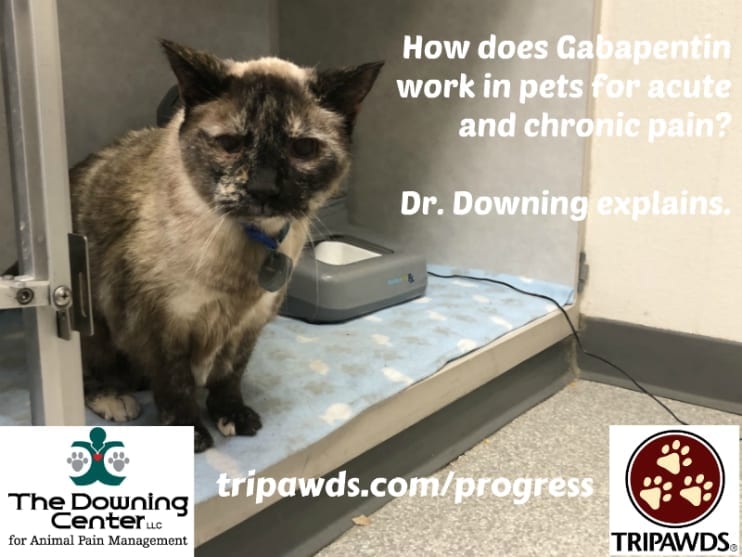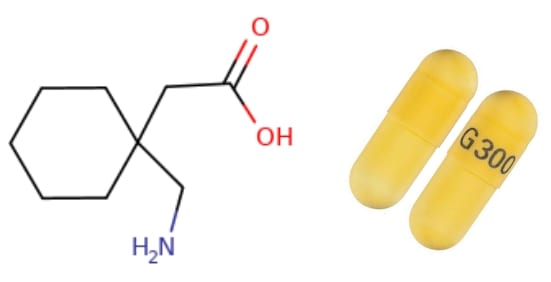More vets than ever seem to be prescribing the nerve pain drug Gabapentin for acute and chronic pain in animals. But exactly how Gabapentin works in Tripawds (and other pets!) has always seemed like a mystery–until now. Sit back for a plain English explanation from pet pain expert Dr. Robin Downing.
Learn How Gabapentin Works in Tripawds (and other pets!)

In our most important video chat with Dr. Downing yet, she shares important information about Gabapentin for pets. This comes on the heels of our recent Tripawds Nutrition blog post about phantom pain relief with St. John’s Wort.
Today, you can watch and learn about the uses, dosages and effects of the more conventional phantom pain relever, Gabapentin. Get to know how it works in animals from the world’s leading pet pain management expert and friend of the Tripawds community.
Then, watch all of Dr. Downing’s important Tripawd tips, including:
Video 1: Why we must advocate for our Tripawds
Video 2: How to know if your pet is in pain
Video 3: The truth about phantom leg pain in Tripawds
Video 4: How to treat amputation recovery pain in pets
Video 5: Help manage Tripawd phantom pain with Gabapentin
Video 6: Pet pain quality of life tips
Video 7: How to help a Tripawd age well
Transcript:
Managing Pain in Pets with Gabapentin
Tripawds: Tell me a little bit about Gabapentin in a post-operative setting. How is it used to relieve pain post-operatively, versus long-term pain management?
Dr. Downing: Gabapentin is a really useful pain tool, really, really useful pain tool. Unfortunately, we’re in the really early stage in veterinary medicine in understanding how it should be used, meaning acute pain versus chronic pain. And, how it should be used in terms of dosing.
We have just not gotten blinded studies that really let us know how we should be dosing this medication.
But as someone who has been using Gabapentin as a tool for both acute and chronic pain, based on the human work and extrapolating that to animal use, I can assure you that over a greater than 15-year period, I have seen this drug be a game-changer for both acute pain as well as chronic pain.

How Gabapentin Helps Acute Pain
Let’s talk about Gabapentin in the acute pain phase. What Gabapentin does is it works on the dorsal horn of the spinal cord where pain signals are modulated as they go up to the brain to the pain-perceiving centers of the brain, and it helps the body just modulate those signals.
In the human literature, Gabapentin actually was shown to decrease the use of patient-administered, patient-controlled analgesic. That’s the pump that people talk about where they push a button and they get a dose of Morphine or they get a dose of Oxycodone as a part of their post-operative orthopedic recovery, immediately post-op.
Well, in the studies that were done, patients who were having a total knee arthroplasty (acknowledged to be the most painful orthopedic condition that people have, total knee replacement), in those patients who got Gabapentin as part of their post-operative pain relief, they used less of the opiate.
In my post-operative patients, I don’t reach for Gabapentin for every post-operative patient. But if they’re having a big procedure, an orthopedic procedure like a TPLO or a spinal decompression because they’ve had an intervertebral disk rupture, or they’re having an amputation where I’m cutting a nerve, I want to target that nerve pain. So I will use Gabapentin then.
Do you need to wean pets off Gabapentin?
If they don’t have other orthopedic issues that might imply that they would benefit from Gabapentin chronically, what I will do is use it at a fairly aggressive dose in the first two to four weeks post-operatively and then wean them off.
We do not have to wean them off the same way we wean patients off of steroids, for instance. It can be a little quicker than that.
What’s the best Gabapentin dose for dogs and cats?
If the only time we’re using that Gabapentin is for the immediate post-operative time, my colleagues will often ask me, “Well, how high a dose should I use?” and my answer is:
we want to use a big enough dose to control the pain and just a little bit less than what makes the patients sedate.
The patients are going to vary. So I have some dogs that are what I refer to as “cheap drunks” and they cannot hold their “liquor.” They actually need a much lower dose of Gabapentin to keep them comfortable and not make them sedated.
Then the other dogs that I deal with who need a bigger dose in order to be comfortable and still not sedated.
The dosing range might be as low as 10 milligrams per kilogram. The dose might be as high as 50 milligrams per kilogram per dose. It really depends on the patient.
That’s for acute pain.
Gabapentin for Chronic Pain Management in Pets
Let’s look at chronic pain management with Gabapentin. Again, understanding the chronic pain means that there have been changes in the nervous system that allow pain to become a self-perpetuating state. That place in the nervous system that is responsible for that is the dorsal horn of the spinal cord.
Gabapentin has an exquisitely specific place in the dorsal horn that it works on. What it does is it takes the threshold for the firing of the nerve, from minimal stimulation back up to where it belongs.
I talk about this as though we are resetting the thermostat on a hot water heater. I want that thermostat to be back up where it belongs. I don’t want it to be way down here. I don’t want a light touch like this to cause pain.
If I have a nervous system and it’s not working properly, a very light touch will actually cause pain and suffering in that animal.
But if I can use Gabapentin to take the threshold for discomfort from a light touch to a more normal, firm pressure, that is a way for me to take that pain state and restore what should be perceived as pressure and not be perceived as a painful touch.
[End of transcript]